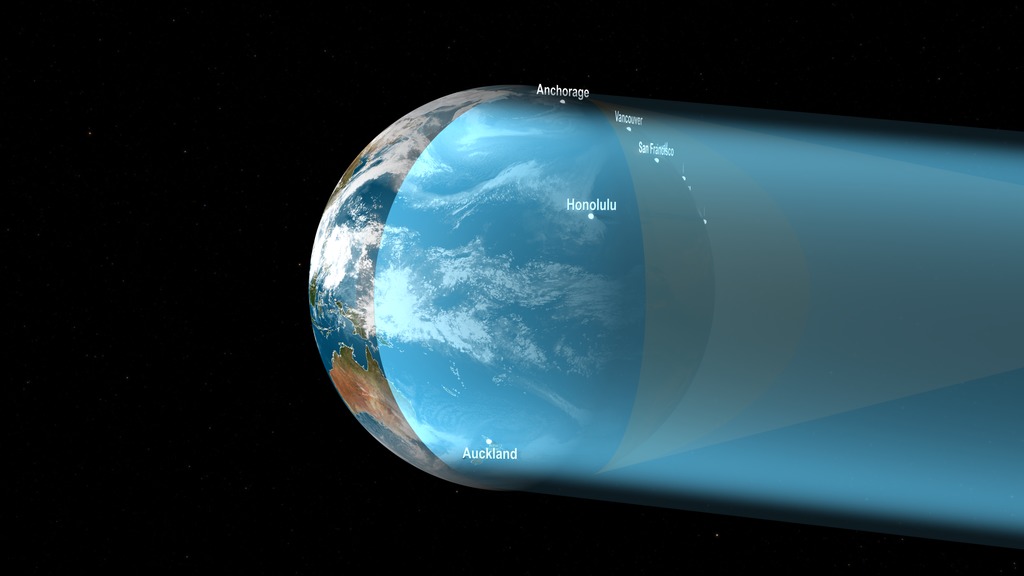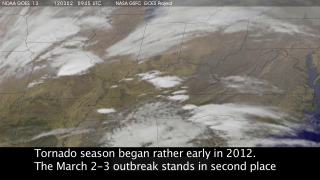NOAA Interview Opportunity: Ready to GOES! NOAA’s Latest GOES Weather Satellite Ready To Launch Next Week!
From Earth weather to space weather, NOAA’s fleet of geostationary satellites play an important role in our everyday lives. And on June 25th, the fourth and final installation of the GOES-R series is set to launch from NASA’s Kennedy Space Center.
As the final satellite in NOAA’s GOES-R (Geostationary Operational Environmental Satellites) series, GOES-U will continue to provide fast, clear and reliable weather-tracking information. GOES-U will provide real-time data for monitoring severe weather, hurricanes, wildfires, floods, fog and even lightning. Not only that, GOES-U carries a suite of instruments, including the first operational compact coronagraph, to monitor the Sun and warn us of approaching space weather hazards. A coronagraph is an instrument that blocks out the bright disk of the Sun so that researchers can see our star’s fainter outer atmosphere where much of the solar activity originates. This new coronagraph will better detect and characterize coronal mass ejections.
The GOES series of weather satellites are parked in a geostationary orbit at points over the equator and rotate at the same speed as the Earth. The fixed location provides continuous coverage of weather conditions across the Western hemisphere. Once in orbit GOES-U will be renamed GOES-19. After an on-orbit check out to ensure its instruments and systems are working properly, GOES-19 will go into service as GOES-East, replacing GOES-16. In this location, GOES-19 will watch over most of North America, including the contiguous United States and Mexico, as well as Central and South America, the Caribbean, and the Atlantic Ocean to the west coast of Africa.
Live interviews are available June 25, 2024, between 6 a.m. - 1 p.m. EDT
Click here to request an interview: https://forms.gle/ny5wyq2mP52hQcyu7
Requests sent via the above form will have scheduling priority. Please do not email requests.
Find out more about GOES and other NOAA missions here @NOAASatellites and https://www.nesdis.noaa.gov/goes-u
Suggested Anchor Intro:
The nation’s most advanced fleet of weather satellites is about to get an update. Later today the fourth and final installation of NOAA’s GOES-R series will launch from NASA’s Kennedy Space Center. The new satellite, named GOES-U, will join the fleet that helps keep us safe here on the ground and in space. Welcome NOAA expert XX live from Cape Canaveral where GOES-U will launch in just a few hours.
Suggested Questions:
1. What is the GOES-U mission and why is it important?
2. GOES-U is the final installment in the series and we hear it has a new instrument on board that will be focused on space weather from the Sun. Can you tell us about this new instrument?
3. Here in our area, we’re particularly concerned about ______. How will GOES-U help forecasters better predict these types of extremes? [stations choice]:
Wildfire and smoke monitoring and tracking
Hurricane & storm tracking
Lightning tracking
Flooding
4. What are you most excited about with the GOES-U launch?
5. How can viewers watch the launch today and keep up to date on this mission?
Questions for longer interviews:
6. What's next after GOES-U? What does NOAA have planned?
7. Once GOES-U is launched, where will it be positioned in orbit?
8. What is a geostationary orbit, and why is it used for the GOES satellites?

Cut b-roll for the live shots. TRT 8:51. Clips are separated by a slate with associated question. No audio on clips.

Banner in Spanish
Pre-recorded interview with Pamela (Pam) Sullivan / NOAA Director for Office of Geostationary Earth Orbit Observations. TRT 4:49. Soundbites are separated by a slate with the associated question. Full transcript available under the download button.
Questions include:
1. What is the GOES-R series mission and why is it important?
2. As the last satellite in NOAA's series of advanced geostationary satellites, what is special about GOES-U?
3. How will the new solar instrument on GOES-U provide better space weather predictions?
4. How will GOES-U help forecasters better predict weather extremes?
5. What are you most excited about with the GOES-U launch?
6. Where can our viewers learn more about GOES-U? (@NOAASatellites on social media)
7. What's next after GOES-U? What does NOAA have planned?
8. Once GOES-U is launched, where will it be positioned in orbit?
9. Wht is a geostationary orbit, and why is used for the GOES satellites?
Pre-recorded interview with Pamela (Pam) Sullivan / NOAA Director for Office of Geostationary Earth Orbit Observations. TRT 4:39. Soundbites are separated by a slate with the associated question. Full transcript available under the download button.
Questions include:
1. What is the GOES-R series mission and why is it important?
2. As the last satellite in NOAA's series of advanced geostationary satellites, what is special about GOES-U?
3. How will the new solar instrument on GOES-U provide better space weather predictions?
4. How will GOES-U help forecasters better predict weather extremes?
5. What are you most excited about with the GOES-U launch?
6. Where can our viewers learn more about GOES-U? (@NOAASatellites on social media)
7. What's next after GOES-U? What does NOAA have planned?
8. Once GOES-U is launched, where will it be positioned in orbit?
9. Wht is a geostationary orbit, and why is used for the GOES satellites?
For More Information
See the following sources:
Credits
Please give credit for this item to:
NASA's Goddard Space Flight Center
Producers
- Michelle Handleman (KBR Wyle Services, LLC)
- Angel Kumari (NASA/GSFC)
- Lauren Colvin (NASA/GSFC)
- Alexa Figueroa (NASA Interns)
Technical support
- Aaron E. Lepsch (ADNET Systems, Inc.)
Editor
- Elizabeth C. Wilk (KBR Wyle Services, LLC)
Release date
This page was originally published on Monday, June 17, 2024.
This page was last updated on Friday, June 21, 2024 at 4:10 PM EDT.
![Music:"Fathoms” by Marc Aaron Jacobs [ASCAP]; ELIAS Music; Universal Production Music“Nova” by Lorenzo Castellarin [BMI]; Volta Music; Universal Production Music“Eye of the Sky” by Jonathan Elias [ASCAP] & David Ashok Ramani [ASCAP]; ELIAS Music; Universal Production Music“Recompense” by Marc Aaron Jacobs [ASCAP]; ELIAS Music; Universal Production Music“A Better Tomorrow” by Frederik Wiedmann [BMI]; Icon Trailer Music; Universal Production MusicComplete transcript available. This video can be freely shared and downloaded. While the video in its entirety can be shared without permission, some individual imagery provided by Artbeats, zefart/Pond5, sinenkiy/Pond5, and BlackBoxGuild/Pond5 through permission and may not be excised or remixed in other products. For more information on NASA’s media guidelines, visit https://www.nasa.gov/multimedia/guidelines/index.htmlComplete transcript available.](/vis/a010000/a014600/a014601/GOEStoGeoXO_YTThumbnail_NOAA.jpg)
![Music: “Potential Energy” by Andy Blythe [PRS] and Marten Joustra [PRS]; Flexitracks; Universal Production Music“The Unexplained” by Daniel Burrows [PRS], Daniel Mallender [PRS], and Thomas Richard Hill [PRS]; BBS Production Music; Universal Production MusicComplete transcript available.](/vis/a010000/a014500/a014554/GOESU_MissionOverview_Short_FINAL_UHD.01417_print.jpg)
![Music: “Enduring Faith,” by Frederik Wiedmann [BMI]; Icon Trailer Music; Universal Production MusicAdditional GOES-T Footage Courtesy of:Lockheed MartinAdditional Wildfire Footage:CALFIRE_Official/flickr under CC BY-NC 2.0National Interagency Fire CenterCALFIRE_Official/Alaska Fire Service/flickr](/vis/a010000/a014100/a014108/14108_WildfireDetectionandMonitoring_FINAL.03921_print.jpg)

